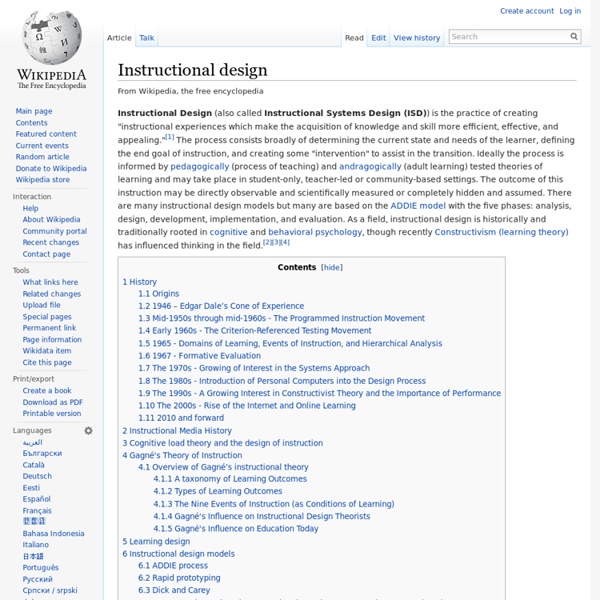Instructional design

Differentiated Instruction with UDL
By Tracey Hall, Nicole Strangman, and Anne Meyer Note: Updated on 11/2/09; 1/14/11; Please visit the AIM Center home page. Introduction Not all students are alike. Based on this knowledge, differentiated instruction applies an approach to teaching and learning that gives students multiple options for taking in information and making sense of ideas. Differentiated instruction is a teaching theory based on the premise that instructional approaches should vary and be adapted in relation to individual and diverse students in classrooms (Tomlinson, 2001). This report on differentiated instruction and UDL begins with an introduction to differentiated instruction in which we provide the definition, a sampling of considerations and curriculum applications, and research evidence for effectiveness. The literature review in this paper is also available as a stand alone document, with annotated references. Top Definition Figure 1. Identifying Components/Features Content Process Products Figure 2.
What does an instructional designer do?
In the past few months, I’ve been asked by a number of different people what an instructional designer does and how to get into the field. I love instructional design because it is a field where I am constantly learning and I have a great variety in what I do. I use so many different skills—writing, web design, graphics, collaboration, planning, plus of course how people learn. Since this question has come up more than once, I thought it would be useful to collect all the information I have emailed people privately and post it here. This will be a series of posts over the week or so. So without further ado, here’s the first installation: What does an instructional designer do? I’m emphasizing “experiences” here deliberately, even though that isn’t always how others would describe the job. If all you’re doing is dumping content into PowerPoint slides or text to read, you don’t need an instructional designer. How do we do that? Update: Other Posts in this Series Free Subscription
Outcomes, Learning Activities, Assessment.
Steps to create outcomes-based assessment: Define or review outcomes for your program. This may include both student learning outcomes and service unit outcomes. Align outcomes with activities of the program. Definition of an academic support program student learning outcome: Student learning outcomes within academic support programs describe the expected knowledge, skills, attitudes, competencies, and habits of mind students are expected to acquire as a result of interaction with your program, services and/or events. take into consideration the HSU mission and institutional level outcomes and professional standards such as those proposed by the Council for the Advancement of Standards in Higher Education (CAS); are understandable by multiple audiences; are reviewed regularly and revised to reflect current standards in the profession; are shared with students; are prominently posted in the program location and in program documents. Definition of a service unit outcome (SUO):
Creating significant learning experiences: an integrated approach to ... - L. Dee Fink
Related:
Related:



